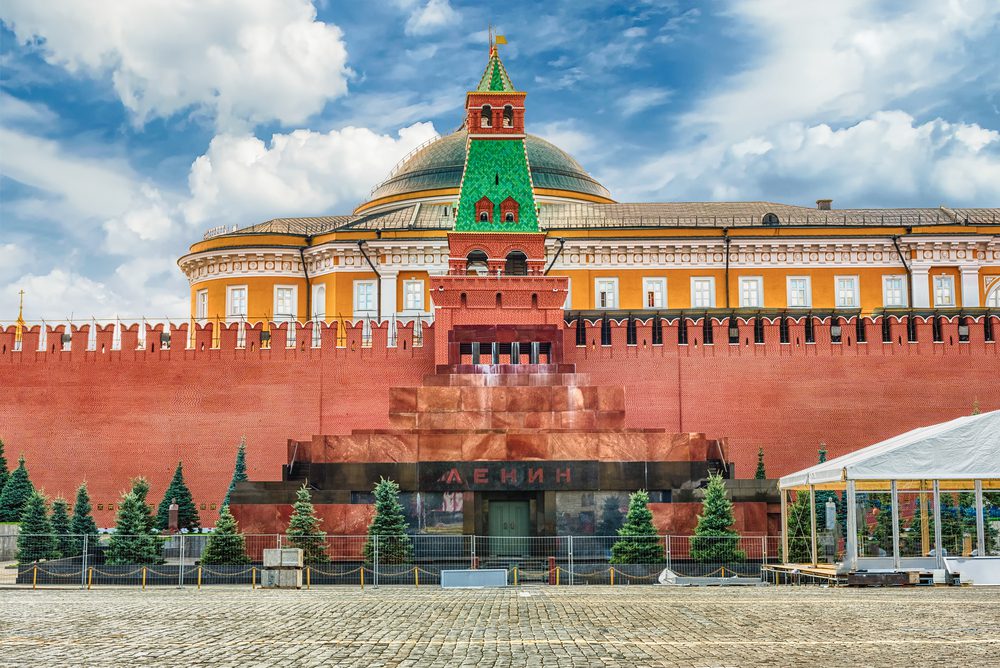When we think of mummies, the imagination instantly flicks to ancient civilizations preserving the deceased to ensure a smooth passage into the afterlife. However, even godless societies of the modern age have their own traditions of mummification. Chief among them are the communist regimes of the 20th century, which made many of their boldest leaders into mummies for very different reasons.
On January 24, 1924, the mastermind of Russia’s communist revolution – Vladimir Lenin – died at age 53 following his final of many strokes. The head of Communist Russia had been in poor health for several years before his ultimate demise, allowing a savvy upstart by the name of Joseph Stalin to start lining his path to power.
It’s said that Lenin condemned many of the would-be successors vying for power on his deathbed, but the sharpest criticism was aimed at Stalin, who he wanted to be stripped of his position in the party. Although Stalin was aware of how poorly Lenin thought of him, this didn’t stop him from venerating him for his own ends.
Promptly after an autopsy, it was agreed by a commission of doctors that the brain of the former communist leader should be subject to detailed scientific study with the aim of pinpointing the “material substrate” of his genius.
Marxism was depicted as a science with a strict materialist worldview. There were no spirits or gods, so the brain that drove the revolution had to be understood like the inner workings of an engine.
The study of Lenin’s brain has been described as “one of the most exciting and simultaneously questionable chapters in the history of medicine.” However, this strange research project had more to do with propaganda and myth-making than medicine.
Lenin’s Mausoleum, iconic resting place of Vladimir Lenin in the center of Red Square, Moscow, Russia. Image credit: Marco Rubino/Shutterstock.com
The findings of the project were twisted and shaped by the Stalinist faction in the politburo who wanted to forge a cult of personality that celebrated Lenin as an immortal superhuman, while simultaneously flaunting the success of Soviet science. In doing this, they could hold up Lenin as an unquestionable god-like figure and Stalin as his inevitable successor.
The process of picking apart the Bolshevik’s brain started in 1925 when researchers removed the organ from his skull, took measurements of its shape and size, then preserved it in a glass jar filled with a formaldehyde solution.
Under the supervision of German neurobiologist Oskar Vogt, the brain was then cut into thousands of wafer-thin slices using a microtome and stained for microscopic investigation. The sacred brain was then compared with the brains of ten “average people,” as well as the brains of other great Russian thinkers, including Ivan Pavlov of salivating dog fame.
The researchers claimed that his brain showed high levels of organization in brain regions associated with areas of speech, recognition, and action. They also argued his brain had a much chunkier temporal lobe – associated with the retention of visual memory, language, and understanding emotion – than other brains that belonged to great artists and poets.
However, much of this was pseudoscientific spin. The belief that brain structure and intelligence are tightly linked has since been discredited. It’s estimated that brain size accounts for just 9 to 16 percent of the overall variability in general intelligence. In other words, it’s way more complex than a matter of size.
It’s also notable that the research into Lenin’s brain has produced a microscopic amount of published scientific literature following the provisional results in 1929, despite it perhaps being one of the most studied individual brains in history.
Politically speaking, however, the mythologizing of Lenin’s mind was a success. Despite his wishes, Lenin was the central subject of a potent personality cult within the Soviet Union until its dissolution in 1991. The story of his heroic mind became a large part of that narrative, often used to gloss over the brutal authoritarianism that went into hyperdrive under the rule of Stalin.
Even today, this narrative still lingers on. Following his funeral, Lenin’s brainless body went on public display in Lenin’s Mausoleum on Red Square next to the Kremlin. It was briefly moved during World War Two and has gone through several revamps over the decades, but it’s remained in the heart of Moscow for almost 100 years.
Man holds a picture of Vladimir Lenin marking the 138th anniversary of Lenin’s birth in front of the Mausoleum at Red Square in 2008. Image credit: kojoku/Shutterstock.com
This has proved to be a costly exercise. In 2016, Russia’s government announced it would spend around $200,000 on preserving Vladimir Lenin’s embalmed body. According to some reports, the corpse has been treated with a cocktail of chemicals including glycerol, formaldehyde, potassium acetate, alcohol, hydrogen peroxide, acetic acid, and acetic sodium. To help maintain his looks, many of his saggy facial features were also reshaped with paraffin, glycerin, and carotene.
When the USSR dissolved in 1991, Boris Yeltsin strongly considered the idea of closing the mausoleum and burying Lenin next to his mother, as if to symbolize Russia breaking away from its communist past. Besides anything else, it was costing a small fortune.
His successor, Vladimir Putin, disagreed. He felt that many Russians still had a deep connection to the earthly remains of Lenin. In his attempt to rebuild Russia from the ruins of communist rule and restore its former glory, Putin argued that the old legend of Lenin couldn’t die just yet.
“In my view we should not touch this, at least while we have very many people who connect their own lives with this… connect this with achievements of the past, of the Soviet years,” Putin said in 2019.
Source Link: The Mummy And Mind Of Vladimir Lenin Still Haunts Russia's Imagination
